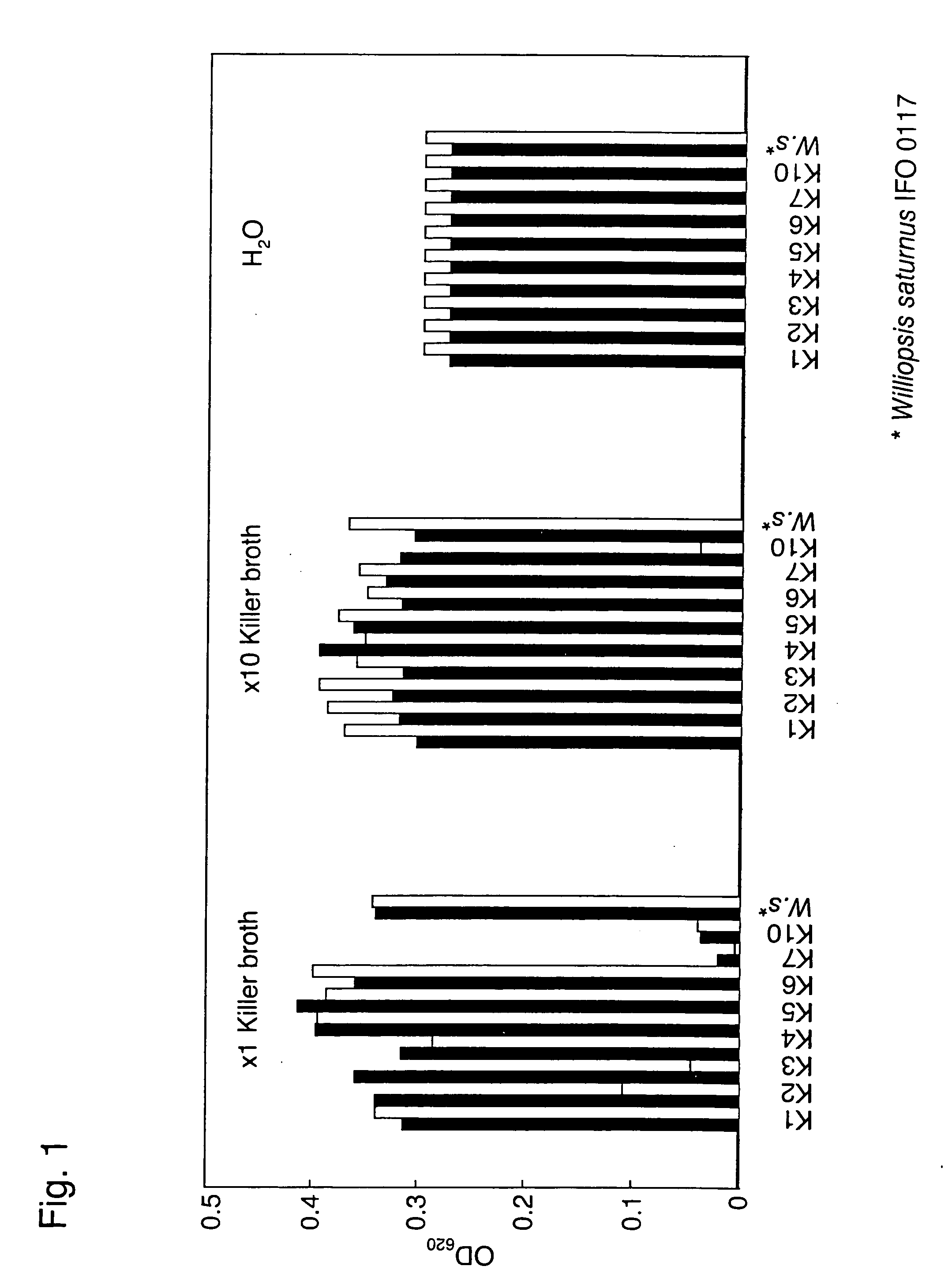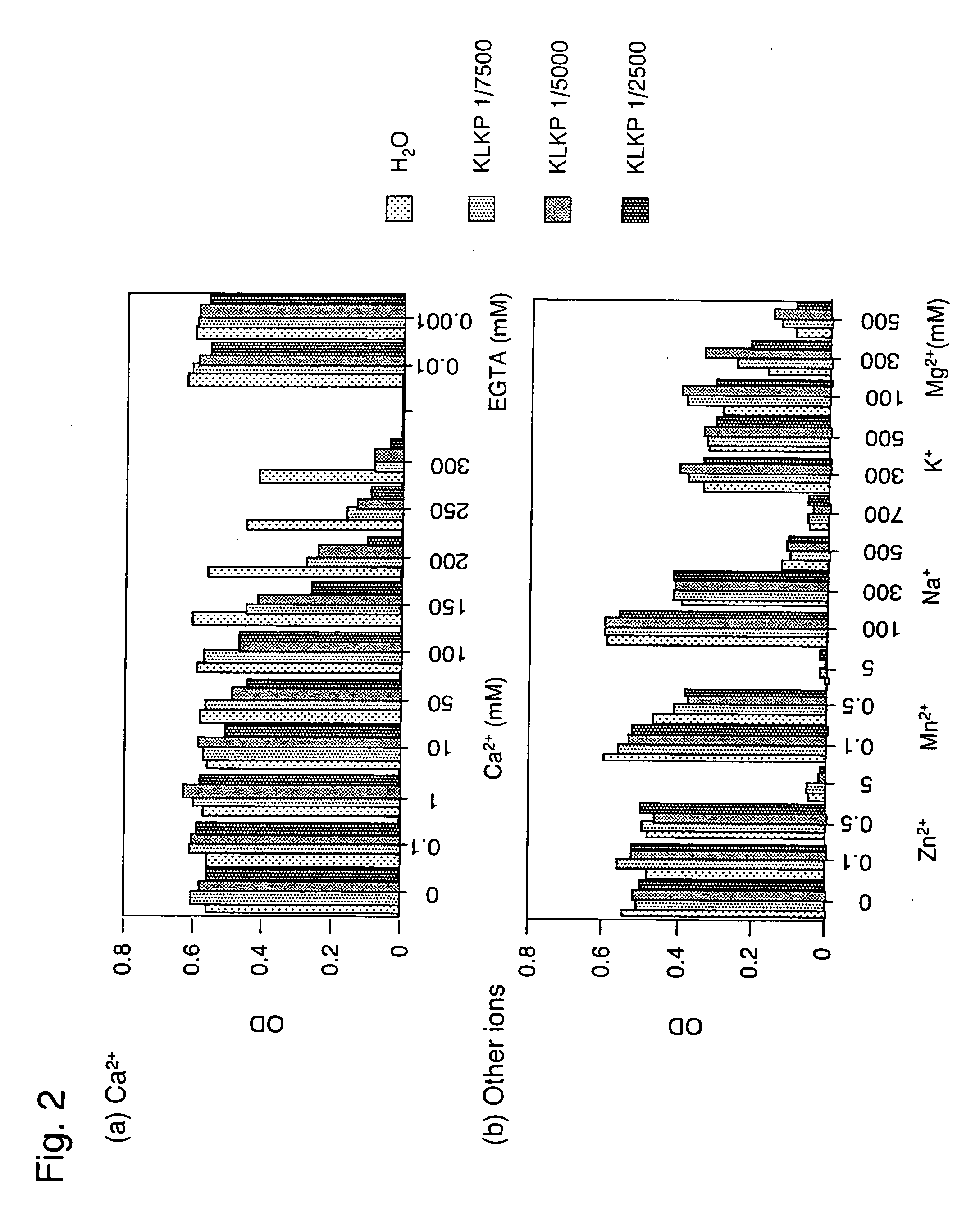Calcineurin activators
a technology of calcineurin and activator, which is applied in the field of calcineurin activator, can solve the problems of inability to fully understand the mechanism of the killer activity, the number of easily available calcineurin activators is very small, and the industrial application of calcineurin activator is limited. it can prevent such aerobic deterioration, suppress the proliferation of lactic acid-assimilating wild yeast, and improve the preservation quality
- Summary
- Abstract
- Description
- Claims
- Application Information
AI Technical Summary
Benefits of technology
Problems solved by technology
Method used
Image
Examples
example 1
Purification of Killer Protein (KLKP) Produced By Kluyveromyces lactis Killer Yeast.
[0072] 100 ml of YPD medium (yeast extract 1%, peptone 2%, and glucose 2%) in which the Kluyveromyces lactis yeast IFO1267 strain had been inoculated was put in a 500 ml flask, and then the yeast was subjected to rotation and shake culture overnight at 28° C. and 220 rpm. 1.3 L of the broth was centrifuged. The resulting supernatant was filtered with a 0.2 μm filter, and then concentrated to 10 ml using a ultrafiltration system (Asahi Kasei Corporation. ACP-1010 and SLP-0053). After substitution with a 10 mM potassium phosphate buffer (pH 6.8), the resliltant was adsorbed to a hydroxyapatite column (Nacalai Tesque, Inc., 187-37, 100-200 mesh) that had been equilibrated with the same buffer. After washing with a 10 mM potassium phosphate buffer (pH 6.8), the killer protein was eluted using a 400 mM potassium phosphate buffer (pH 6.8). Fractions having killer activity were collected, dialyzed using a ...
example 2
Increase in Intracellular Ca2+ Level and Activation of Calcineurin by Killer Protein (KLKP) Produced by Kluyveromyces lactis Killer Yeast
[0073] 9 types of killer yeast culture filtrates were caused to act on budding yeast in the presence of Ca2+, and then growth inhibition was examined. The 9 types of killer yeasts were the Saccharonmyces cerevisiae NCYC235 strain (hereinafter, the name of a killer type is K1), the Saccharomyces cerevisiae NCYC738 strain (K2), the Saccharonmyces cerevisiae NCYC761 strain (K3), the Candida glabrata NCYC388 strain (K4), the Pichia anomala NCYC434 strain (K5), the Kluyveromyces arxianus NCYC587 strain (K6), the Candida valida NCYC327 strain (K7), the Kluyveromyces lactis NCYC575 strain (K10), and the Williopsis saturnus var. saturnus IFO0117 strain. Furthermore, proliferation of cell cycle-related gene variants in the presence of various metal salts was examined on a 96-well microplate using KLKP that had been purified using the hydroxyapatite column ...
example 3
Suppression of Cultured Plant Cell Proliferation by Killer Protein (KLKP) Produced by Kluyveromyces lactis Killer Yeast
[0094] 1 ml of cultured tobacco cells (BY cells) that had been grown at 28° C. for 7 days was added to 20 ml of a Muraslige and Skoog medium containing 3% sucrose. KLKP was added to the medium at a final concentration between 1 / 100 and 1 / 100000, and then cultured for 5 days at 28° C. and 115 rpm. The broth containing cells was transferred into a calibrated test tube, and then allowed to stand. The amount of the precipitated cells was measured. Furthermore, cells to which no KLKP had been added and cells to which KLKP had been added at a concentration of 1 / 100 were stained with the DAP1 fluorescence reagent, so that the morphology of the cells and the nuclei could be observed.
[0095] As a result, in the presence of KLKP at a concentration of 1 / 100, the proliferation of the culture cells was approximately half of that of the cells to which no KLKP had been added. Eve...
PUM
| Property | Measurement | Unit |
|---|---|---|
| Fraction | aaaaa | aaaaa |
| Sensitivity | aaaaa | aaaaa |
| Disorder | aaaaa | aaaaa |
Abstract
Description
Claims
Application Information
 Login to View More
Login to View More - R&D
- Intellectual Property
- Life Sciences
- Materials
- Tech Scout
- Unparalleled Data Quality
- Higher Quality Content
- 60% Fewer Hallucinations
Browse by: Latest US Patents, China's latest patents, Technical Efficacy Thesaurus, Application Domain, Technology Topic, Popular Technical Reports.
© 2025 PatSnap. All rights reserved.Legal|Privacy policy|Modern Slavery Act Transparency Statement|Sitemap|About US| Contact US: help@patsnap.com



